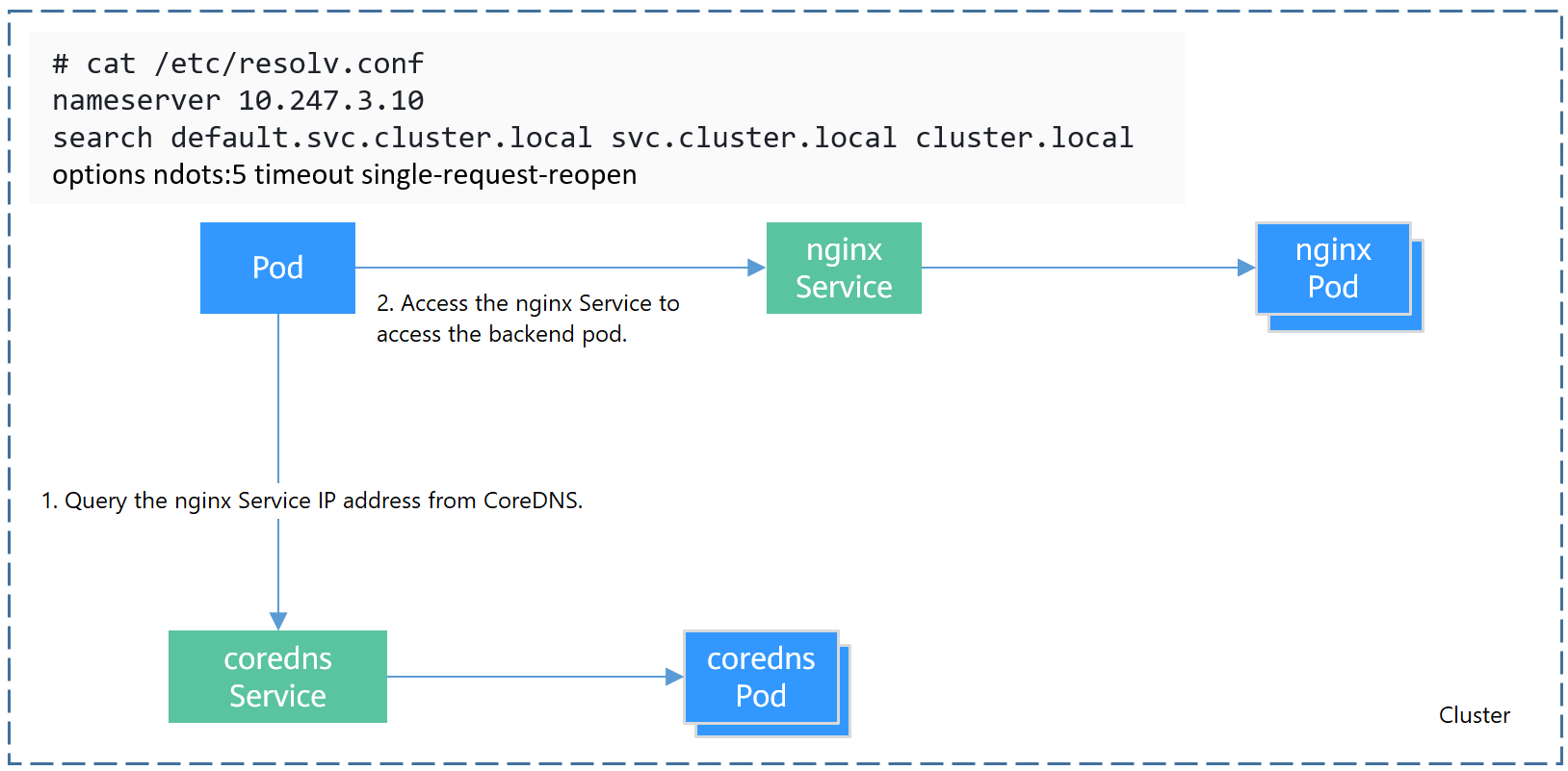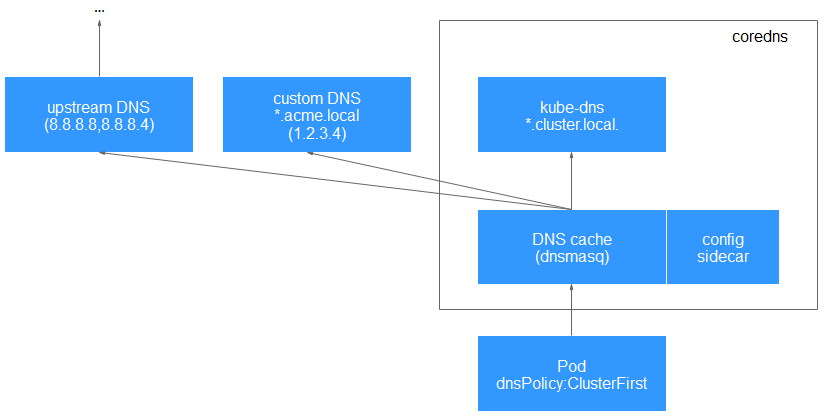Overview
Introduction to CoreDNS
When you create a cluster, the CoreDNS add-on is installed to resolve domain names in the cluster.
You can view the pod of the CoreDNS add-on in the kube-system namespace.
$ kubectl get po --namespace=kube-system NAME READY STATUS RESTARTS AGE coredns-7689f8bdf-295rk 1/1 Running 0 9m11s coredns-7689f8bdf-h7n68 1/1 Running 0 11m
After CoreDNS is installed, it becomes a DNS. After the Service is created, CoreDNS records the Service name and IP address. In this way, the pod can obtain the Service IP address by querying the Service name from CoreDNS.
nginx.<namespace>.svc.cluster.local is used to access the Service. nginx is the Service name, <namespace> is the namespace, and svc.cluster.local is the domain name suffix. In actual use, you can omit <namespace>.svc.cluster.local in the same namespace and use the ServiceName.
An advantage of using ServiceName is that you can write ServiceName into the program when developing the application. In this way, you do not need to know the IP address of a specific Service.
After CoreDNS is installed, there is also a Service in the kube-system namespace, as shown below.
$ kubectl get svc -n kube-system NAME TYPE CLUSTER-IP EXTERNAL-IP PORT(S) AGE coredns ClusterIP 10.247.3.10 <none> 53/UDP,53/TCP,8080/TCP 13d
By default, after other pods are created, the address of the CoreDNS Service is written as the address of the domain name resolution server in the /etc/resolv.conf file of the pod. Create a pod and view the /etc/resolv.conf file as follows:
$ kubectl exec test01-6cbbf97b78-krj6h -it -- /bin/sh / # cat /etc/resolv.conf nameserver 10.247.3.10 search default.svc.cluster.local svc.cluster.local cluster.local options ndots:5 timeout single-request-reopen
When a user accesses the Service name:Port of the Nginx pod, the IP address of the Nginx Service is resolved from CoreDNS, and then the IP address of the Nginx Service is accessed. In this way, the user can access the backend Nginx pod.

How Does Domain Name Resolution Work in Kubernetes?
DNS policies can be configured for each pod. Kubernetes supports DNS policies Default, ClusterFirst, ClusterFirstWithHostNet, and None. For details, see DNS for Services and Pods. These policies are specified in the dnsPolicy field in the pod-specific.
- Default: Pods inherit the name resolution configuration from the node that the pods run on. The custom upstream DNS server and the stub domain cannot be used together with this policy.
- ClusterFirst: Any DNS query that does not match the configured cluster domain suffix, such as www.kubernetes.io, is forwarded to the upstream name server inherited from the node. Cluster administrators may have extra stub domains and upstream DNS servers configured.
- ClusterFirstWithHostNet: For pods running with hostNetwork, set its DNS policy ClusterFirstWithHostNet.
- None: It allows a pod to ignore DNS settings from the Kubernetes environment. All DNS settings are supposed to be provided using the dnsPolicy field in the pod-specific.

- Clusters of Kubernetes v1.10 and later support Default, ClusterFirst, ClusterFirstWithHostNet, and None. Clusters earlier than Kubernetes v1.10 support only Default, ClusterFirst, and ClusterFirstWithHostNet.
- Default is not the default DNS policy. If dnsPolicy is not explicitly specified, ClusterFirst is used.
Routing
Without stub domain configurations: Any query that does not match the configured cluster domain suffix, such as www.kubernetes.io, is forwarded to the upstream DNS server inherited from the node.
With stub domain configurations: If stub domains and upstream DNS servers are configured, DNS queries are routed according to the following flow:
- The query is first sent to the DNS caching layer in CoreDNS.
- From the caching layer, the suffix of the request is examined and then the request is forwarded to the corresponding DNS:
- Names with the cluster suffix, for example, .cluster.local: The request is sent to CoreDNS.
- Names with the stub domain suffix, for example, .acme.local: The request is sent to the configured custom DNS resolver that listens, for example, on 1.2.3.4.
- Names that do not match the suffix (for example, widget.com): The request is forwarded to the upstream DNS.

Related Operations
You can also configure DNS in a workload. For details, see DNS Configuration.
You can also use CoreDNS to implement user-defined domain name resolution. For details, see Using CoreDNS for Custom Domain Name Resolution.
You can also use DNSCache to improve the DNS resolution performance. For details, see Using NodeLocal DNSCache to Improve DNS Performance.
Feedback
Was this page helpful?
Provide feedbackThank you very much for your feedback. We will continue working to improve the documentation.See the reply and handling status in My Cloud VOC.
For any further questions, feel free to contact us through the chatbot.
Chatbot





